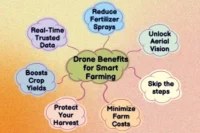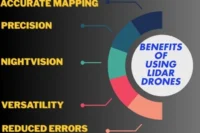Do Drones Have Heat Sensors for Farm and Home Use
Published: 3 Aug 2025
When I first flew a drone over my farm, I didn’t think much about heat sensors. But then I got curious, do drones have heat sensors that could help me check plant health? Turns out, they do. I upgraded to a drone with thermal imaging, and it changed everything. I could spot dry patches, overwatered areas, and even sick plants just by looking at heat differences. That one feature saved me hours of work and made my crops healthier. Heat sensors are not just for big industries, they are useful for everyday tasks too.
What Are Heat Sensors in Drones
A heat sensor in a drone, also called a thermal sensor, is a special camera that sees temperature instead of light. Unlike regular cameras that capture colors and brightness, a thermal sensor picks up heat coming from objects. Every plant, animal, or object gives off some heat—even if we can’t see it with our eyes. The thermal sensor turns this heat into an image using colors like red, yellow, blue, or green to show different temperatures. So instead of seeing how something looks, you see how hot or cold it is. This helps you find things like dry soil, sick plants, or even animals hiding in tall grass.
Thermal Camera vs. Normal Camera
When we hear the word “camera,” we often think of the ones that take photos in daylight. But thermal cameras are different. They don’t show us pictures the way we see them with our eyes. Instead, they show temperature differences. Let’s look at how they compare:
Color vs. Heat
A normal camera captures light and color, like red, green, and blue. A thermal camera captures heat and shows it as colors, like yellow for warm spots and blue for cool spots.
Daylight Needed
Regular cameras need light to see clearly. They struggle at night or in dark places. Thermal cameras don’t need light. They work by detecting heat, so they work great in total darkness.
Surface Details vs. Temperature
A normal camera shows surface details like shapes, edges, and patterns. A thermal camera shows where something is hot or cold, even if the surface looks the same.
How Do Thermal Drones Work
Thermal drones use special sensors that detect infrared radiation, which is a type of heat energy given off by all objects, whether they are living things, buildings, or soil. The hotter something is, the more infrared heat it releases. These sensors pick up that heat and convert it into a thermal image. Instead of showing regular colors like a normal photo, the image shows temperature differences using shades like red, yellow, or blue. This lets users “see” heat patterns that are invisible to the naked eye, helping them spot hot spots, leaks, or problem areas quickly and clearly.
Step-by-Step Use Example
Wondering what it’s like to use a thermal drone in real life? Here’s a simple breakdown of how a drone with a heat sensor works during a typical flight over a farm:
1. Drone Takes Off
The drone is launched and flies above the field. It starts scanning the land below using its built-in thermal sensor, even if it’s early morning, late evening, or cloudy.
2. Heat Detection Begins
As it flies, the sensor picks up differences in surface temperature. Warmer areas—like dry soil—send out more heat. Cooler areas—like shaded or wet zones—send out less.
3. Thermal Images Are Captured
The drone records these temperature changes as images. These images use colors to show heat differences. For example, red might show a hot area, and blue might show a cool one.
4. Software Creates a Heat Map
After the flight, the drone’s software puts the images together into a full heat map of the field. This map helps the farmer see where to water more, check for disease, or fix irrigation issues.
Uses of Thermal Imaging in Agriculture
Thermal drones are becoming powerful tools for farmers. By showing heat patterns from above, they help spot problems that might go unnoticed from the ground. Here’s how they are making a real difference in farming:
Crop Health Monitoring
Thermal imaging helps farmers quickly find areas where crops are stressed. Dry spots, overwatered zones, or sick plants often show up as unusual heat patterns, making it easier to take action early.
Irrigation Checks
Uneven watering can hurt plant growth. With thermal images, farmers can clearly see which parts of a field are too dry or too wet and adjust irrigation systems more accurately.
Livestock Tracking
Warm animals like cows or goats show up easily in thermal images, even at night or when they’re hiding in tall grass. This makes it simpler to keep track of them over large areas.
Save Time and Labor
Instead of walking through acres of land to look for issues, farmers can fly a drone in minutes. This cuts down on time and effort while giving a full view of the farm.
Not Just for Farmers: Other Everyday Uses
Thermal drones are not just helpful in agriculture. Many people use them in everyday situations where seeing heat differences can solve problems or improve safety.
Home Inspections
Thermal drones can spot heat escaping from roofs, cold drafts around windows, or warm spots caused by faulty wiring. This helps homeowners find hidden problems in walls, floors, or attics without breaking anything open.
Security and Surveillance
At night or in low light, it’s hard to see with regular cameras. Thermal drones can detect people or animals by their body heat—even if they’re behind bushes, fences, or in the dark.
Firefighting and Rescue
Firefighters use thermal drones to locate fire hot spots inside buildings and on roofs. In rescue missions, drones help find people trapped in smoke, rubble, or remote areas by picking up their body heat.
Wildlife Observation
Researchers and nature lovers use thermal drones to track animals without disturbing them. Since the drones stay in the air and use heat instead of bright lights, they’re perfect for quiet, nighttime monitoring in forests or open land.
How It Changed My Farming Routine
Before I started using a thermal drone, I had to walk through the fields, checking one section at a time. It took hours and still left me guessing in some areas. Once I added a drone with a heat sensor, everything changed.
Faster Crop Checks
Instead of spending half a day inspecting my land, I now fly the drone for just 20 minutes. It covers the entire area and gives me a clear view of where things are going wrong.
Better Crop Care
With thermal images, I can see which parts of the field are too dry or holding too much water. I fix issues before they spread, which helps my crops stay healthy and strong.
Less Waste, More Savings
I no longer waste water on areas that don’t need it. I also avoid over-fertilizing by targeting only the spots that need attention. This has saved both money and resources.
A Smart Upgrade
At first, I wasn’t sure if it would be worth it. But after seeing how much time and effort it saved—and how much healthier my crops looked, I knew it was a smart investment.
Things to Keep in Mind
Thermal drones are powerful tools, but they’re not one-size-fits-all. Before you buy or use one, it’s good to understand a few important points.
Not All Drones Have Heat Sensors
Many drones made for photography or hobby flying don’t include thermal imaging. Only some mid to high-end models come with built-in heat sensors. Make sure to check the specs before you buy.
Thermal Drones Can Be Expensive
Drones with heat sensors usually cost more than standard models. If you only need basic features like video or photos, a cheaper drone might be enough. But for thermal tasks, the extra cost can be worth it.
Requires a Bit of Learning
Reading thermal images takes practice. At first, the colors and heat patterns might be confusing. But once you get the hang of it, you’ll be able to spot issues quickly and make smarter decisions.
Match the Drone to Your Needs
Think about what you need the drone for—farming, inspections, or security. Don’t pay extra for features you won’t use. Pick a drone that fits your goals and your budget.
Conclusion
So, do drones have heat sensors? Yes, many of them do, and they’re not just for big industries or experts. Thermal drones can help with farming, home inspections, safety checks, and much more. They show what our eyes can’t see, making it easier to catch problems early and take action fast.
Even if you are not a tech expert, learning about drone sensors can help you do smarter work—on farms or beyond. With the right drone and a bit of practice, you will be flying with more purpose and getting better results every time.





